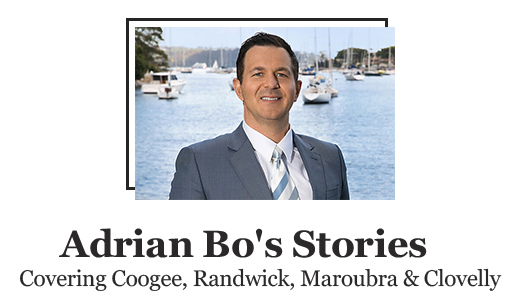Lurline Bay
Adrian is at the serene Lurline Bay between Coogee and Maroubra to talk about the area including
➥ The local singer that hand carved a 12m channel on the rocks.
➥ The extraordinary experiment that took place there in the 1920s.
➥ The Lilli Pilli Estate Subdivision that formed the Lurline Bay community.
➥ Hector Street turning into Marine Parade, Undine Street and Inman Street. Long Bay Road turning into Malabar Road and Nelson Road turning into Duncan Street.
Hi, it’s Adrian Bo and today I’m at Lurline Bay, a beautiful little enclave wedged between Coogee Beach and Maroubra Beach. Now this beautiful bay was once known as Lilli Pilli Bay and in fact the residential area around Lurline Bay has evolved mainly through a subdivision of land known as the Lilli Pilli Estate. A poster in The New South Wales State Library Archives, which was advertising one of the subdivisions of the Lilli Pilli Estate in 1926 shows a few very interesting things. Firstly it shows a road called Hector Street running along the oceanfront and feeding into Lurline Bay, which appears to be what became Marine Parade, as well as sections of Undine Street and Inman Street. Malabar Road was once also known as Long Bay Road. Not surprisingly, the origins of some of the street names in Lurline Bay have a nautical theme.
Liguria Street was named after a ship on the Orient Line, Undine Street was named after one of the faithful tug boats being used in Sydney Harbour. Cuzco Street was named after a ship that sailed between South America and Sydney, Cuzco also being the name of the Inca capital in Peru. Duncan Street was once known as Nelson Road and Gordon Street. Ron Filbee Place commemorates a prominent member of the Maroubra Surf Club who sadly passed in a car crash in 1958. Banks Street was once called Victoria Road but was then named after Captain Cook’s botanist, Sir Joseph Banks. Now there’s a particularly fascinating story attached to Lurline Bay concerning a gentleman by the name of Percy Bates who was one of Sydney’s leading tenors. Bates travelled the world singing, and perhaps as a result of his travels, he became obsessed with the ocean. Living in Lurline Bay, he became fascinated by the potential of turning the energy of the waves into electric power.
This led to him in 1920, carving a 12 metre by two metre channel by hand into the rocky approach to the water in order to construct a hydroelectric machine or wave machine as it was known then. Carving the channel took him five years and Bates managed to generate 5,000 watts of power at high tide, enough to power the lights in his shed and several radiators. He filed a patent in 1928 under the title of “Improvements in and relating to the utilisation of wave motion,” quote, unquote. Locals considered him eccentric despite his achievement. Eventually, Bates passed away in 1949, and in the 1950s, there were still remnants of his experiment. He was a man ahead of his time. Now, I’ve been selling real estate in this area for 32 years and our office has been very successful in selling some of the following homes in Lurline Bay, or sometimes referred to as South Coogee, and my colleague, Martin Farah, in particular. 5 Crana Avenue, 4 Bloomfield Street, 47 Cuzco Street, 18 Alexandria Parade, 16 Alexandria Parade, and I personally have sold number 68 Marine Parade, which was a record price for just under four million and also 73 Torrington Road, another semi there for a record price just under three million. What a beautiful area this is and what an inspiration Percy Bates was, and the channel that he spent five years carving is still beautifully preserved today. Enjoy the start of Autumn and always remember, your home is worth more with Adrian Bo.


